- Small Dog Place Home
- Lifestyle
- Exercising and Bonding with Your Small Dog
Exercising and Bonding with Your Small Dog: 7 Tips to a Successful Attachment
Exercising and Bonding with Your Small Dog by Karol King Last Updated 04-10-2024.
Obesity may be plaguing adults and children in the U.S. Still, dogs are also experiencing the effects of the sedentary lifestyle. The Association of Pet Obesity Prevention estimates that over 100 million dogs and cats are overweight or obese.
To be precise, over 56% of dogs need to lose weight. Although healthy weight loss should be undertaken under the supervision of a vet and approached with a ‘slow but steady’ philosophy, exercise can play an important role in weight loss for most dogs.
When your dog begins to burn more calories than he consumes, he will start to show a healthier, more lithe physique. If you would like to get more active as well, why not join your dog in the Great Outdoors and at home, taking part in activities that are fun but also cardiovascularly effective?
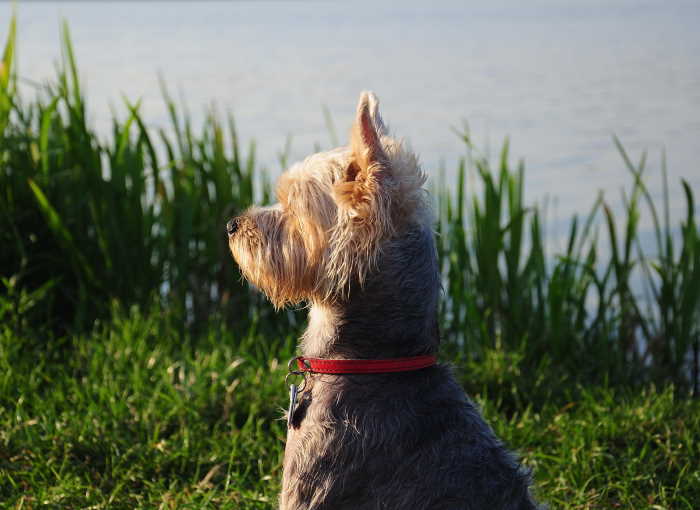 Exercising and Bonding With Your Small Dog: Photo by Piotr Stefański on Unsplash
Exercising and Bonding With Your Small Dog: Photo by Piotr Stefański on UnsplashChoosing the Right Activity for Your Small Dog
Most dogs are happy to head outside and let off some steam, but the right workout will differ depending on your dog’s age and breed.
For instance, brachycephalic dogs (those with ‘flat snouts’ such as Boston Terriers, French and English bulldogs, and Pugs) can overheat faster than dogs with longer snouts as their panting is less efficient. Heat stroke is a serious problem that can affect some dogs in hot weather.
Special care should, therefore, be taken with these pups during warmer months. Older dogs and those with joint issues and heart and other conditions will also be less able to withstand heavy exercise.
Finally, some small dog breeds (like terriers and chihuahuas) make good running partners; others may not enjoy a high-impact run. If you are planning an intense workout like running or hiking, run it by your vet first to ensure these activities are suitable for your dog.
7 Tips for Exercising and Bonding With Your Small Dog
Table of Contents
2. Enjoying the time in the Great Outdoors
6. Swimming in Natural Bodies of Water
7. Backyard Fun
1. Taking it Slowly
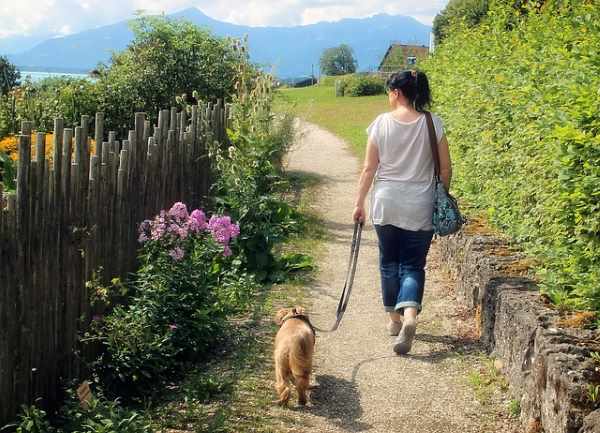 Taking it slowly is a great first step to exercising and bonding with your small dog.
Taking it slowly is a great first step to exercising and bonding with your small dog.Taking things easy is also essential. If you want to take your dog for a jog, for instance, start out by walking, then brisk walking, then jogging just part of the way.
Always bring water and be sensitive to signs that your dog is getting tired. If your dog pants, cough, or has labored breathing, she may have exercise intolerance.
If she shows extreme signs of tiredness (such as fainting or lethargy), consider it an emergency and take him to the veterinarian immediately.
2. Enjoying Time in the Great Outdoors
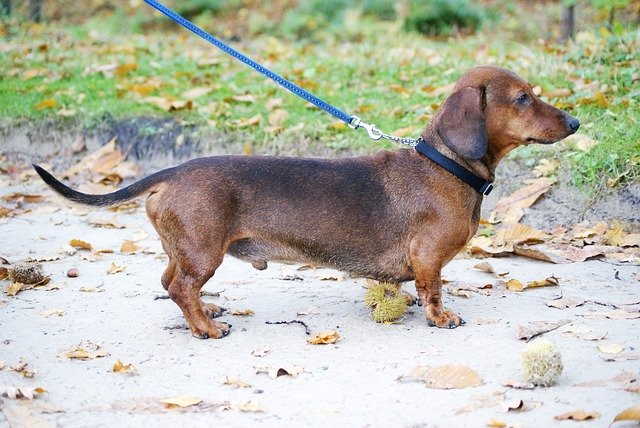
There is no need to plan something fancy when it comes to working out with your pet. Start out by taking a half-hour walk with your small dog. Walk briskly, and your pooch will have no trouble keeping up.
Try to head to a spot at a specific distance from your home; a park or forest area is perfect. Once you are there, entertain your pooch with games like fetch.
Of course, allow him a few minutes to just smell the flowers, earth, and other beautifully fragranced elements in nature. Try to organize to meet friends so your dog can socialize with other friendly canines.
3. Taking it Up a Notch
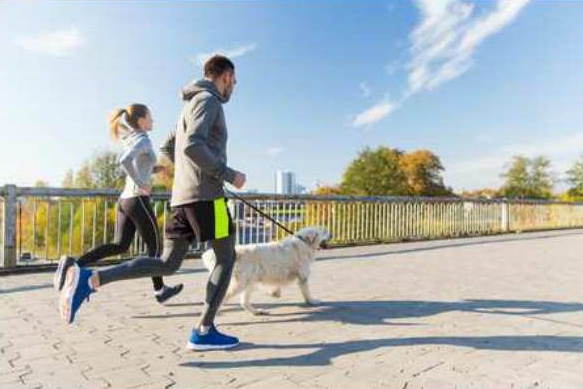 Some dogs naturally take to jogging making exercising and bonding with your small dog much easier.
Some dogs naturally take to jogging making exercising and bonding with your small dog much easier.If your aim is to eventually jog, start out by interspersing short springs with your normal walking rhythm. Use the same word every time to let your dog know it is time to pick up the pace - for instance, “Jog!” or “Run!” will do.
Build your own and your pooch’s endurance up slowly by including more ‘running’ spurts and by gradually lengthening the amount of time you are running.
The American Kennel Club reminds all dog owners that warming up and cooling down are as important for pooches as they are for human beings. You should also avoid running when it is too hot and humid. Offer your dog water frequently and stop running if your dog starts lagging behind or shows you other signs of wanting to stop. During exercise, dogs can get dehydrated too if not given enough water to drink.
4. Got Wheels, Will Travel
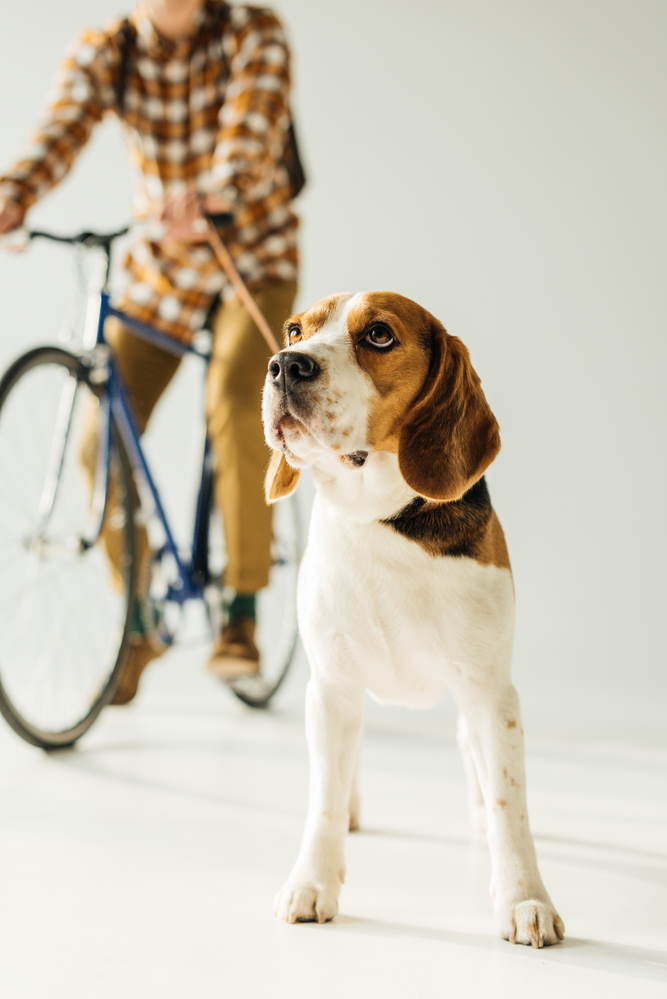 Exercising and bonding with your small dog can be done if you love to cycle.
Exercising and bonding with your small dog can be done if you love to cycle.If you enjoy cycling and you have a very fit terrier or other ultra-fit small dog, you might like to try cycling with them running alongside you. One proviso is that simply using a leash will not do; the leash could get caught under the wheels can cause accidents and injury.
If your small dog is older or unable to run, place him in a secure basket while you cycle; the extra pounds will make your workout a little harder. If your dog is keen on running next to you, a bicycle leash attachment will keep him by your side, but at a safe distance from your wheel.
Adaptors can cost in the region of $40, but this can be considered a good investment for frequent dog-human cycling teams.
5. Swimming in the Summer
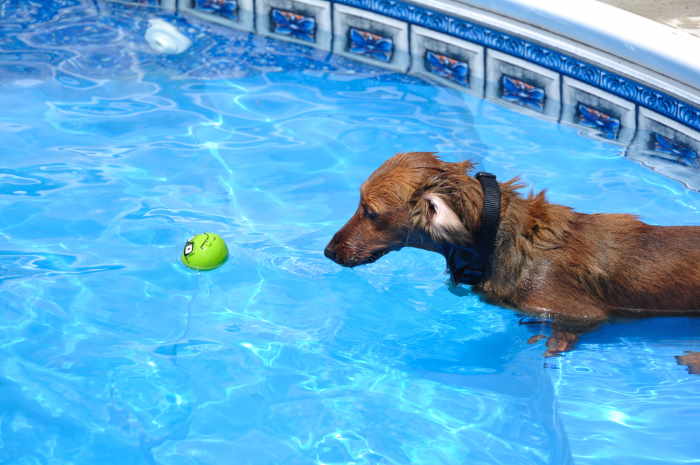 Exercising and bonding with your small dog is easy if you have access to a swimming pool.
Exercising and bonding with your small dog is easy if you have access to a swimming pool.If you have a swimming pool, your dog might already be a seasoned swimmer. If you have a new small dog, then you will need to teach him to swim.
Any time you have dogs or, indeed, any other type of four-pawed pet, surrounding your pool with a safety fence is a good way to avoid drowning. Some dogs, such as English bulldogs, have a higher drowning risk because their heads are heavy.
However, even bulldogs can swim, provided they have the right training. Your dog should wear a well-fitting, high-quality life jacket. This will keep them afloat and help them feel secure while they paddle away. To teach your small dog to swim, get in the water with him in the shallow end and have him swim to you.
Start out with a very small distance and gradually increase the distance. Teach him to find the steps and get in and out of the water. Ensure the first few lessons last just a few minutes and gradually increase your swim time.
6. Swimming in Natural Bodies of Water
If you plan on swimming with your small dog in lakes, rivers, and other natural bodies of water, consult your vet first. Your vet will most likely recommend vaccination against Giardia — a microscopic parasite that causes intestinal problems.
Be wary of natural bodies of water as a rule, simply because they can house microorganisms like blue-green algae (which is poisonous to dogs), leptospirosis (which causes fever and lethargy and is potentially lethal) and other parasites.
These microorganisms are often impossible to spot, so water that looks safe and tastes fresh may actually be dangerous.
A saltwater pool is an ideal place to swim with your pooch. Ensure that he or she is always protected with a life jacket, and if you have a pool at home, surround it with a fence.
This way, you know your dog will never accidentally fall into the pool. When teaching your dog to swim, start on the shallow end and make sure your dog knows how to make his way to the steps if he has had enough water time and simply wants to lay in the sun.
If you and your little canine friend are hoping to get fitter or lose weight, exercise together is an ideal way to stay motivated. Walking, running, and cycling are a few activities you might consider.
7. Backyard Fun
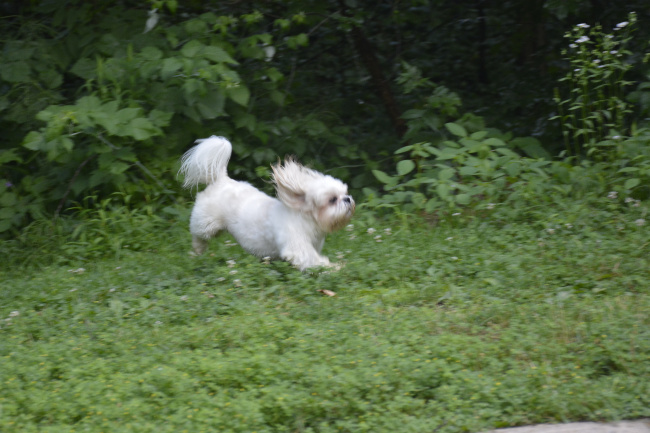 Exercising and bonding with your small dog may be as easy as opening your back door.
Exercising and bonding with your small dog may be as easy as opening your back door.What do you do if you want to combine exercising and bonding with your small dog and don't have access to a swimming pool, natural lake, or even a jogging trail?
Why not just have fun near your home with a game of fetch, frisbee, or tug-o-war? Dogs are not particular and any time you spend with them brings them closer to your heart.
Design an obstacle resembling an agility course and even if you have no plans to compete, your dog will love running through, jumping over, or weaving around an agility course.
No large pool? No problem, purchase a small kiddie pool for both of you to enjoy. You can soak in the cool water and your dog can splash about.
No hiking trails? A walk around the neighborhood can be just as fulfilling with smells galore for your pooch and friendly neighbors for you to meet. What better way to spend an afternoon.
Final Thoughts: Exercising and Bonding With Your Small Dog
If you do opt for cycling, invest in a proper support leash that will keep your pooch far away from the wheel. Swimming is a wonderful activity in the summer; it can give your heart a good workout while working out all your major muscle groups yet remaining gentle on your joints.
Author Bio: Exercising and Bonding with Your Small Dog
Karol is animal lover who has dedicated her life to helping dogs to find a safe and happy home. She now works as a freelance writer, which is her passion, and has the freedom to spend more time at home with her wonderful family.
Other Articles by Karol King
Traveling With Small Dogs: Tips for a Safe Trip
Through the years, more dog owners are choosing to bring their pets during travel. A pet survey in 2012 reveals that 85% of pet owners choose dogs over other animals for them to travel with. (More)
6 Signs Your Shih Tzu is Overweight
According to the Association for Pet Obesity Prevention, approximately 56 percent of adult dogs are clinically overweight. (More)
Improve Indoor Air Quality: Could the Air In Your Home Make Your Dog Sick?
Most of us would be shocked to discover that indoor air pollution can be anywhere from 2 to 20 times as dangerous as outdoors. (More)
Did You Find Exercising and Bonding With Your Small Dog Interesting?
About Janice (author and voice behind this site)
Janice Jones has lived with dogs and cats for most of her life and worked as a veterinary technician for over a decade. She has also been a small-breed dog breeder and rescue advocate and holds academic training in psychology, biology, nursing, and mental health counseling. Her work focuses on helping dog owners make informed, responsible decisions rooted in experience, education, and compassion.
When not writing, reading, or researching dog-related topics, she likes to spend time with her six Shih Tzu dogs, her husband, and her family, as well as knitting and crocheting. She is also the voice behind Miracle Shih Tzu and Smart-Knit-Crocheting
Does This Article Deserve Your Thumbs Up?
We always appreciate your support and encouragement. Your thumbs up means so much to us. Please like this article.
If you find this page or any page on Small Dog Place Helpful, or useful in anyway, I'd love it if you would click the small heart found on the bottom right of each page.
You can also share or bookmark this page -- just click on the:

Free Monthly Newsletter
Sign Up for Our Free Newsletter and get our Free Gift to You.
my E-book, The Top 10 Mistakes People Make When Choosing a Dog (and how to avoid them)







